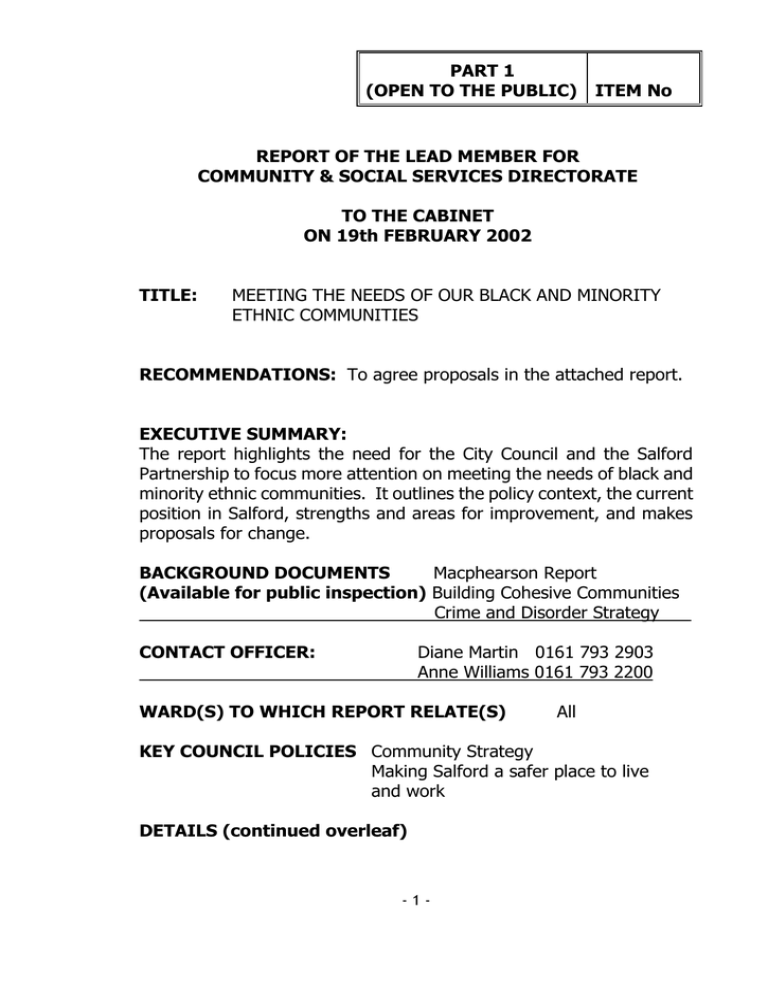PART 1 (OPEN TO THE PUBLIC) REPORT OF THE LEAD MEMBER FOR
advertisement

PART 1 (OPEN TO THE PUBLIC) ITEM No REPORT OF THE LEAD MEMBER FOR COMMUNITY & SOCIAL SERVICES DIRECTORATE TO THE CABINET ON 19th FEBRUARY 2002 TITLE: MEETING THE NEEDS OF OUR BLACK AND MINORITY ETHNIC COMMUNITIES RECOMMENDATIONS: To agree proposals in the attached report. EXECUTIVE SUMMARY: The report highlights the need for the City Council and the Salford Partnership to focus more attention on meeting the needs of black and minority ethnic communities. It outlines the policy context, the current position in Salford, strengths and areas for improvement, and makes proposals for change. BACKGROUND DOCUMENTS Macphearson Report (Available for public inspection) Building Cohesive Communities Crime and Disorder Strategy CONTACT OFFICER: Diane Martin 0161 793 2903 Anne Williams 0161 793 2200 WARD(S) TO WHICH REPORT RELATE(S) All KEY COUNCIL POLICIES Community Strategy Making Salford a safer place to live and work DETAILS (continued overleaf) -1- BACKGROUND A number of factors have recently come together to focus our attention on meeting the needs of the black and minority ethnic communities in Salford. There has been a growth in black and minority ethnic populations in Salford. The 1991 census figure of 2.1% is expected to rise in the 2001 census. Indeed recently, in order to develop a Housing Renewal Strategy in Higher Broughton, 13% of the population in the area surveyed by the Housing Directorate were from ethnic minorities. Furthermore, the diversity of the populations and their spread into different parts of the City is increasing with the arrival of refugees and asylum seekers. Events last year in Oldham and Burnley have focused national and local government thinking about how the needs of black and minority ethnic communities are met and in December, two reports on Community Cohesion were published. These reports, "Building Cohesive Communities" and the "Community Cohesion Review Team Report" outline the issues and proposals for addressing the social, racial and cultural divisions that exist in communities. Building Cohesive Communities outlines the key issues to be addressed as: Identity and Values - the need to tackle the divisive "them and us" attitudes that characterize relations between different sections of the community in some of the troubled areas; Cohesion and Segregation - the need to address the increasing tendency of different ethnic groups to segregate themselves from each other, retreating into "comfort zones"; Weak Political and Community Leadership - the need to overcome failings in agreeing a vision and in creating inclusive local strategic partnerships that can deliver on an agreed vision; Children and Young People - the need to give young people a voice in decision-making processes; Youth Facilities and Services - the need to address a lack of provision in this area; Employment - the need to address inequalities in the labour market; -2- Regeneration - the need to address the tensions that are created between communities in competing for Government grants and regeneration funds; Activities of Extremist Groups - the report recognises that activities of the British National Party and similar groups serve to exploit and exacerbate tensions between communities. Local Media - the media is accused in some quarters of biased and/or inflammatory reporting of incidents; Policing and Crime Reduction - the need to address variances in the approaches and quality of policing in different parts of the country. A recent report from the Joseph Rowntree Foundation on Black and Minority Ethnic organisations' experience of local compacts found that Black and Minority Ethnic Voluntary and Community Organisations felt they were marginal to local policy debates. They were mainly used by mainstream and statutory agencies to deliver the latter's goals and targets rather than being fully involved in strategic policy discussion; most felt also that they had little access to senior policy-makers or politicians. THE POLICY CONTEXT Within a context of national objectives the government has included a new statutory duty for all public authorities to promote race equality in the Race Relations (Amendment) Act 2000. This duty will make race equality an issue for all authorities irrespective of size of the local minority population. Under the new section 71, public authorities are required to have “due regard” to the need to promote race equality. This wording means the general duty is proportionate. The explanation for the proportionality, in the consultation paper, focuses on the extent to which “individual public functions will lend themselves to a proactive approach”. The Commission for Racial Equality has been empowered to issue a compliance notice to any public authority, which it believed is not fulfilling a specific duty. If necessary, it will be able to seek a Court Order to enforce the notice. The Government expects that such powers will only be used as a last resort. -3- The requirement to deliver racial equality is unambiguous in all the key policy arenas including: The Race Relation (Amendment) Act. (effective from April 2001) which requires local authorities: To produce a plan to achieve the duty to promote racial equality including targets and consultation strategies. To monitor take up of services and address inequalities. To monitor the workforce. To deal with racial harassment. To integrate racial equality into training and development. To promote racial equality and equal opportunities through contracting. To provide translation and interpreting facilities where appropriate. Human Rights Act 1998 Encompasses a statutory duty to ensure services meet the linguistic, religious and cultural needs of diverse communities. Commission for Racial Equality Standards: Race Equality Means Quality.1 This aims to use quality management arrangements to address: Policy and Planning Service Delivery and Customer Care Community Development Employment recruitment and selection Employment development and retention Marketing and corporate image The Stephen Lawrence Report (1999) has major implications on all public authorities in terms of the way they work. The report calls for coordinated action to eradicate racism and for the implementation of local initiatives aimed at promoting cultural diversity and addressing racism. The report also defines 'institutional racism' as the “collective” failure of an organisation, to unwittingly disadvantage minority ethnic people. It 1 Race Equality Means Quality, A Standard for Racial Equality for Local Government in England and Wales. The Commission for Racial Equality. 1995 -4- has been accepted as a characteristic of Local Government as well as the Police Force. The Stephen Lawrence Report places expectations on Public Authorities to: Review the existing policies and practices and their outcome for ethnic minority people. Develop an action plan to tackle institutionalised racism with targets dates, clear objectives and identified officers. Mainstream racial equality principles into policies and practices in the Best Value process. Provide effective training in preventing and challenging racial discrimination, harassment, prejudice and inappropriate behaviour for all staff. Adopt and implement the MacPherson Report definition of racial discrimination and harassment in employment and service delivery. Address inequality in employment and the under-representation of ethnic minority communities in the workforce in particular publicise the partnership commitment to reducing the impact of institutional racism and valuing diversity. Evaluate progress. THE POSITION IN SALFORD Strengths There is a foundation of good practice on which to build work with black and minority ethnic communities in Salford. The City Council has established a number of policies and targets to improve its performance. These include: A policy to combat harassment at work A Recruitment and Selection Code of Practice to ensure that all appointments are made on the basis of equal opportunities Equal Opportunities training programmes for Members and employees An Equal Opportunities Services Delivery Policy and a target to meet level 2 of the Equality Standard in 2002 -5- An Equal Opportunities Forum within its political structures to give high-level involvement in these issues and provide a forum for engaging with representatives of relevant communities of interest Both the Crime and Disorder Partnership and Social Inclusion Task Group have identified issues around black and minority ethnic communities as priorities for action. Learning from the lessons of the Stephen Lawrence Report, a crime reporting system is in place. A new organisation, Salford Multi Agency Racial Harassment Forum (SMARF) is developing to bring together the communities affected by racially motivated crime and the agencies which deal with it. The Police Authority's Ethnic Minority and Jewish Forums enable citizens from these groups to give their views on a range of public services and issues. Community Committees offer a potential local link point for residents. Community teams can be supportive for local developments. Some services are responding well to black and minority ethnic citizens. For example, the Standing Advisory Council for Religious Education (SACRE) brings together all faiths to advise on religious education. Some voluntary organisations are developing appropriate services and providing a voice for black and minority ethnic communities. The Crime and Disorder Strategy has set out within it’s objectives to increase trust and confidence amongst ethnic minority communities and ensure an equitable access to services and support mechanisms. The objective is premised on the assumption that minority communities should be fairly represented in terms of their population. The Strategy aimed to increase the levels of reporting of racially motivated crime, and this is taking place. However it is unclear whether the increase in reporting and recording also reflects an increase in tension within our communities. Anecdotal evidence suggests that this is the case, particularly since the events of September 11 which have been used by some as a reason for targeting Muslims for abuse. The newly established Salford Partnership has recently launched its Community Plan, which addresses the need to increase the participation and influence of black and minority ethnic communities in the delivery -6- of services and activities across the City. The Partnership itself is prioritising the involvement of black and minority ethnic communities in the Partnership, through the development of the Community Network. The Network aims to provide a route into the Salford Partnership for the most hard to reach groups, including black and minority ethnic communities and refugee and asylum seekers. The Police Authority has a continuing programme of consultation with different sections of black and minority ethnic and faith communities, with the focus on policing issues, but identifying the wide-ranging concerns of these residents. Areas for Improvement However, a number of weaknesses in Salford's ability to meet the needs of our black and minority ethnic communities have been identified. The first is the lack of a strategic plan either within the City Council or across the Salford Partnership. There is a lack of information about the effectiveness of what we currently do, which impedes change. Some services are undoubtedly changing to meet new needs, but some are not and there is a lack of clarity about what needs to change and how. This is underpinned by the widespread lack of expertise, knowledge and skills amongst staff about working with black and minority ethnic communities, particularly in leadership roles. For example, there is a lack of understanding of how to respond to racially motivated incidents particularly amongst front line Council staff. This identifies training needs and the necessity to empower front line staff to play their full role supporting victims. Underpinning all this is the lack of engagement of black and minority ethnic communities with service providers, and the weakness of community and voluntary organisations to speak for black and minority ethnic communities. Citizens from black and minority ethnic and refugee and asylum seekers communities can play a key role in expressing their own needs, meeting those needs and taking part in the democratic processes such as community committees. The local communities are in the main organised, but have less influence than in Boroughs where they represent a greater proportion of the population. The Salford ethnic minority voluntary sector has insufficient infrastructure to enable it to provide many services for its communities, -7- although Salford Link based in Eccles is meeting some local needs. The peer review of the City Council by the Improvement and development agency (I&DeA) noted that the Council needs to 'positively respond to and value the needs and differences of an increasingly ethnically diverse community'. It questioned whether the Council had built effective relationships with minority ethnic communities. The recent Social Services Inspection of Children's Services noted in their overall conclusions and recommendations, "Access to minority ethnic and cultural communities needed to be further developed. The Council should improve its knowledge of ethnic and cultural minority communities and ensure that staff feel confident and are working effectively with, and have access to, these communities." PROPOSALS All the agencies working in the City need to adopt a common set of aims which can be implemented within their separate organisations and form the basis for partnership working. These might be: Valuing all citizens equally. Providing effective services to meet the needs of all residents and inspiring confidence within black minority ethnic communities in those services. Responding to legislation effectively. Dealing with racially motivated abuse and crime. Promoting the message that racism will not be tolerated in Salford. Empowering citizens and supporting black minority ethnic voluntary and community groups. Setting and achieving employment targets employment targets Promoting employment practices that value the needs of an increasingly ethnically diverse workforce, e.g in relation to harassment at work. To address these issues it is recommended that: Senior champions at member and officer level within the City Council, and in other organisations, are identified to ensure the issue has -8- high level support and the necessary action is taken. Both the City Council and the Salford Partnership need to develop a vision and comprehensive strategy and means of implementation for meeting the needs of ethnic minority communities. To support working with its strategic partners, the City Council should establish a senior level (i.e. chief officer) working group representing all services and areas of expertise to drive its response to these issues. This group would report to the Equal Opportunities Forum of the Council and the Partnership. Implementing the statutory requirements of the Race Relations (Amendment) Act provides an important immediate practical focus for the City Council and other members of the Salford Partnership. Within the Council, this work should be led by the above-mentioned working group. The strategy needs to be developed in consultation and with the full involvement of black and ethnic minority groups. A senior Policy Post across the Partnership should be created to bring in expertise, to transfer good practice across agencies, and promote change to meet needs. A Race and Hate Crime Co-ordinator is needed to lead on combating these issues. The City should pursue resources from central government to assist us to meet the needs of the black and minority ethnic communities, to establish a Racial Equality Council or similar for the City. A priority in all our work should be the empowerment of black and minority ethnic communities. Appropriate support should be given to black and minority ethnic voluntary organisations including the Salford Multi Agency Racial Harassment Forum. Salford Partnership agencies should adopt the Commission for Racial Equality standard for racial equality in relation to service delivery, customer care and employment practice. Each Directorate within the City Council should examine its services to ensure they are accessible and appropriate to our black and minority ethnic communities. RESOURCES In order to carry out these proposal there are existing and new -9- resources which can be used in imaginative ways: A Community and Race Relation post has recently been created by the Police. In Community & Social Services Directorate a new post will focus on making service delivery appropriate to these communities. A Race and Hate Crime Co-ordinator is to be appointed in the Salford Community Safety Unit, funded from the Neighborhood Renewal Fund. SRB 5 Social Inclusion funds have been allocated for three years and could be used to fund the Salford Partnership policy post identified above. The Chief Executive Directorate has mainstream dedicated resources to: ensure the City Council meets legal requirements as an employer promote best employed practice provide policy, guidance and support to ensure services meet the needs of all residents engage with representatives of excluded groups to influence policy and practice Many of the lottery and other short-term funds prioritise the needs of black and minority ethnic communities. The Partnership needs to ensure that adequate support and guidance is given to community based organisations to enable them to access these resources. On a longer term basis the needs identified by the community and voluntary sector should be met by the mainstream resources. DM/AEW/AW 06 02 02 C:\My Documents\Amended Cabinet Report - Meeting the Needs of our Black.doc - 10 -




